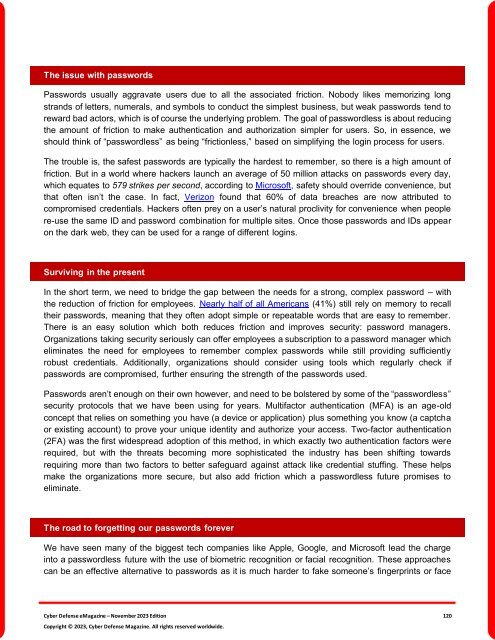The Cyber Defense eMagazine November Edition for 2023
Cyber Defense eMagazine November Edition for 2023 #CDM #CYBERDEFENSEMAG @CyberDefenseMag by @Miliefsky a world-renowned cyber security expert and the Publisher of Cyber Defense Magazine as part of the Cyber Defense Media Group as well as Yan Ross, Editor-in-Chief and many more writers, partners and supporters who make this an awesome publication! 196 page November Edition fully packed with some of our best content. Thank you all and to our readers! OSINT ROCKS! #CDM #CDMG #OSINT #CYBERSECURITY #INFOSEC #BEST #PRACTICES #TIPS #TECHNIQUES
Cyber Defense eMagazine November Edition for 2023 #CDM #CYBERDEFENSEMAG @CyberDefenseMag by @Miliefsky a world-renowned cyber security expert and the Publisher of Cyber Defense Magazine as part of the Cyber Defense Media Group as well as Yan Ross, Editor-in-Chief and many more writers, partners and supporters who make this an awesome publication! 196 page November Edition fully packed with some of our best content. Thank you all and to our readers! OSINT ROCKS! #CDM #CDMG #OSINT #CYBERSECURITY #INFOSEC #BEST #PRACTICES #TIPS #TECHNIQUES
Create successful ePaper yourself
Turn your PDF publications into a flip-book with our unique Google optimized e-Paper software.
<strong>The</strong> issue with passwords<br />
Passwords usually aggravate users due to all the associated friction. Nobody likes memorizing long<br />
strands of letters, numerals, and symbols to conduct the simplest business, but weak passwords tend to<br />
reward bad actors, which is of course the underlying problem. <strong>The</strong> goal of passwordless is about reducing<br />
the amount of friction to make authentication and authorization simpler <strong>for</strong> users. So, in essence, we<br />
should think of “passwordless” as being “frictionless,” based on simplifying the login process <strong>for</strong> users.<br />
<strong>The</strong> trouble is, the safest passwords are typically the hardest to remember, so there is a high amount of<br />
friction. But in a world where hackers launch an average of 50 million attacks on passwords every day,<br />
which equates to 579 strikes per second, according to Microsoft, safety should override convenience, but<br />
that often isn’t the case. In fact, Verizon found that 60% of data breaches are now attributed to<br />
compromised credentials. Hackers often prey on a user’s natural proclivity <strong>for</strong> convenience when people<br />
re-use the same ID and password combination <strong>for</strong> multiple sites. Once those passwords and IDs appear<br />
on the dark web, they can be used <strong>for</strong> a range of different logins.<br />
Surviving in the present<br />
In the short term, we need to bridge the gap between the needs <strong>for</strong> a strong, complex password – with<br />
the reduction of friction <strong>for</strong> employees. Nearly half of all Americans (41%) still rely on memory to recall<br />
their passwords, meaning that they often adopt simple or repeatable words that are easy to remember.<br />
<strong>The</strong>re is an easy solution which both reduces friction and improves security: password managers.<br />
Organizations taking security seriously can offer employees a subscription to a password manager which<br />
eliminates the need <strong>for</strong> employees to remember complex passwords while still providing sufficiently<br />
robust credentials. Additionally, organizations should consider using tools which regularly check if<br />
passwords are compromised, further ensuring the strength of the passwords used.<br />
Passwords aren’t enough on their own however, and need to be bolstered by some of the “passwordless”<br />
security protocols that we have been using <strong>for</strong> years. Multifactor authentication (MFA) is an age-old<br />
concept that relies on something you have (a device or application) plus something you know (a captcha<br />
or existing account) to prove your unique identity and authorize your access. Two-factor authentication<br />
(2FA) was the first widespread adoption of this method, in which exactly two authentication factors were<br />
required, but with the threats becoming more sophisticated the industry has been shifting towards<br />
requiring more than two factors to better safeguard against attack like credential stuffing. <strong>The</strong>se helps<br />
make the organizations more secure, but also add friction which a passwordless future promises to<br />
eliminate.<br />
<strong>The</strong> road to <strong>for</strong>getting our passwords <strong>for</strong>ever<br />
We have seen many of the biggest tech companies like Apple, Google, and Microsoft lead the charge<br />
into a passwordless future with the use of biometric recognition or facial recognition. <strong>The</strong>se approaches<br />
can be an effective alternative to passwords as it is much harder to fake someone’s fingerprints or face<br />
<strong>Cyber</strong> <strong>Defense</strong> <strong>eMagazine</strong> – <strong>November</strong> <strong>2023</strong> <strong>Edition</strong> 120<br />
Copyright © <strong>2023</strong>, <strong>Cyber</strong> <strong>Defense</strong> Magazine. All rights reserved worldwide.

















